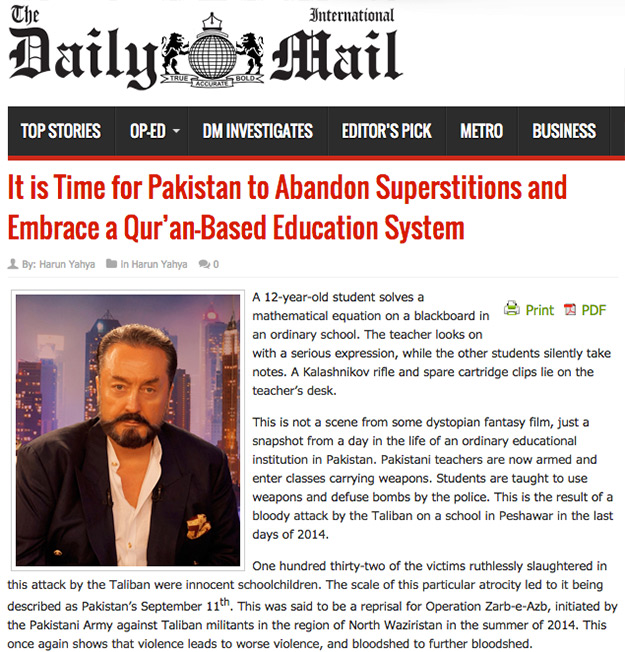
Pakistani teachers are now armed and enter classes carrying weapons. Students are taught to use weapons and defuse bombs by the police
A 12-year-old student solves a mathematical equation on a blackboard in an ordinary school. The teacher looks on with a serious expression, while the other students silently take notes. A Kalashnikov rifle and spare cartridge clips lie on the teacher’s desk. This is not a scene from some dystopian fantasy film, just a snapshot from a day in the life of an ordinary educational institution in Pakistan. Pakistani teachers are now armed and enter classes carrying weapons. Students are taught to use weapons and defuse bombs by the police. This is the result of a bloody attack by the Taliban on a school in Peshawar in the last days of 2014.
Of the victims ruthlessly slaughtered in this attack by the Taliban, 132 were innocent schoolchildren. The scale of this particular atrocity led to it being described as Pakistan’s September 11th. It was said to be a reprisal for Operation Zarb-e-Azb, initiated by the Pakistan army against Taliban militants in North Waziristan during the summer of 2014. This once again shows that violence leads to worse violence and bloodshed to further bloodshed. Pakistan is a country where acts of terror are common. There is nothing odd about Pakistani students receiving anti-terror training. However, equipping educational institutions with weapons is certainly not going to deter the Taliban, put an end to acts of terror or reduce the bloodshed. The radical terrorists who perpetrate such slaughter already intend to die and will not therefore be put off by armed teachers confronting them.
People who believe in the same God and the same prophets are slaughtering one another. They seek solutions through guns and bombs rather than through love, brotherhood and friendship. They are possessed by a spirit of hate, conflict and wrongdoing, which basically causes these incidents. Immediately after the school massacre, the Pakistan government announced a programme aimed against radical organisations. It established a 20 point plan known as the National Action Plan. The plan was intended to combat terror through harsh measures, military operations and executions. However, there was a crucial flaw in it — the plan focused on killing the mosquito rather than drying up its breeding swamps.
The Pakistani Taliban and various other groups that have sworn loyalty to the Islamic State of Iraq and the Levant (ISIL), regard terror and violence as their only means of operation. They are far more radical in nature than the Afghan Taliban, which leans towards negotiations. They are capable of ruthlessly killing little children, innocent women, Shiite Muslims worshipping in mosques and health workers trying to vaccinate children. They are so filled with hatred that they attack and throw acid in the faces of innocent female students.
In order to dry up the breeding swamps, we need to grasp the true origin of this hatred and hostility. However, we must also not labour under the influence of prejudice, anger and emotionality. The Pakistani Taliban seek to overthrow the Pakistan government and impose their own radical model, and they recognise no right to life for any belief or way of thinking other than their own. They commit acts of violence and terror in the name of their ideology. It is this radical ideology that makes the Taliban dangerous, not their weapons. The Taliban ideology consists largely of superstitions, fabricated hadiths and assorted fanatical beliefs that have no place in the true Islam. The faith for which they kill and die is a mistaken one diametrically opposed to the Islam described in the Quran.
The source of the radical belief system that gives birth to and feeds the Taliban’s terror is not the American or Indian secret services or international forces. The root of the problem is not external, but rather it lies in the socio-political institutional structures in Pakistani society, especially the education system. Pakistani youngsters are generally educated either in madrassas or in public schools. There are estimated to be 30,000 madrassas in the country with about 1.5 million students. The madrassas provide free religious education and accommodation, particularly for poor families. However, a significant number of them provide religious training largely based on superstitions and are a far cry from the official curriculum. Some of them are active without the knowledge of the state and their sources of funding are unclear. Most importantly, students receive an education that is fanatical, loveless and filled with hatred in the name of Islam. When they graduate, they propagate these teachings to society at large as religious officials. Such a false education makes it infinitely easy for radicals acting in the name of Islam to gather followers.
Of course, supporters of violence and terror do not come from the madrassas alone. Public educational institutions also produce many young brains with a fanatical way of thinking. Ideas like “Islam and Pakistan are in danger” and “Pakistan is waging a kind of war against the west” are part of the official curriculum. The only way of ridding Pakistan of the breeding grounds of terror and radicalism is education based on the true Islam. No other mode of instruction or threat can produce a solution. Pakistani schools must put an immediate end to their hate-filled talk, and must teach the Islamic messages of love, friendship, affection and compassion. Pakistani madrassas must be places that teach an unadulterated form of Islam and Quranic moral values and they must create a people of love. With the recent school massacre, the people of Pakistan have truly seen how dangerous and horrifying radicalism can be. We sincerely hope that, unlike in the past, the measures adopted will be more than purely superficial ones; we hope that the emphasis this time will be on education, rather than on armed conflict.
Adnan Oktar's piece on Daily Times & Daily Mail:
http://www.dailytimes.com.pk/opinion/23-Mar-2015/pakistan-s-superstitions



